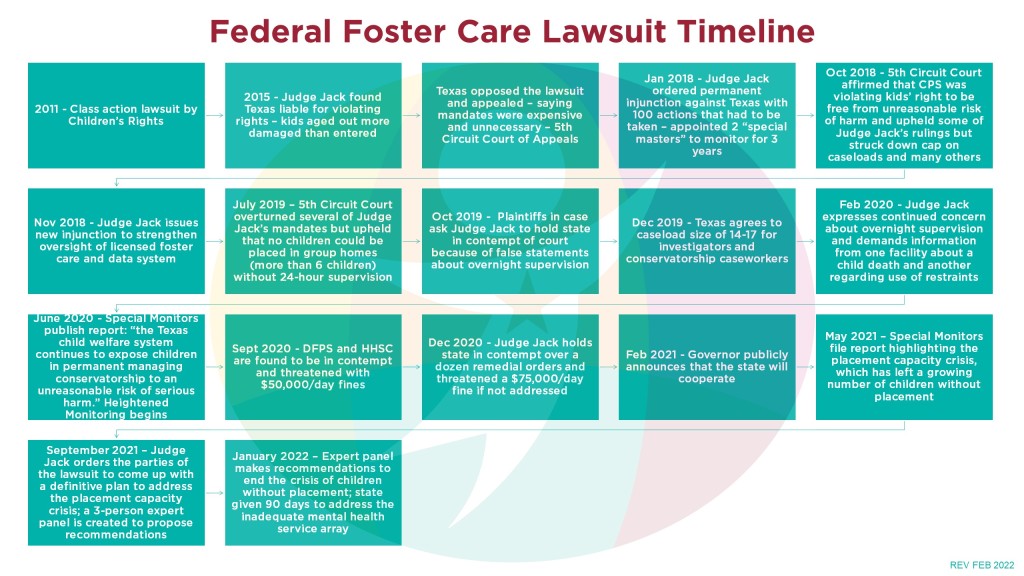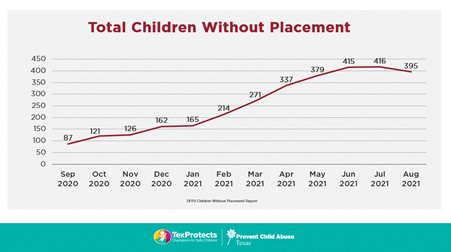This month marks 11 years into a federal lawsuit against the state of Texas, where the state’s foster care system has shown repeatedly that they are engaging in practices that place the children in its care at an unreasonable risk of harm.

During the past year, the number of children without placement, often referred to as CWOP, has been a significant focus of the lawsuit proceedings due to the 378% increase of children that were sleeping in CPS offices or other unregulated settings. While placement shortage is often cited as the cause for CWOP, there are deeper root causes such as inadequate behavioral and medical health supports for children, which was a highlighted recommendation of the expert panels’ presentation of many short and long-term strategies to Judge Jack in January. The state was given 90 days to plan actions for better mental health access for children in CPS custody and the deadline is quickly approaching.

The Department of Family and Protective Services and the Health and Human Services Commission (responsible for monitoring and regulation of facilities) have since responded with their progress and plan. They have mostly agreed to pursue the 23 expert panels’ recommendations that are intended to foster better coordination and accountability between DFPS and HHSC; expand access to and resources for children, families, and family-like settings; and improve practice to align with the guiding principles and practice model. As we approach the next legislative session, TexProtects has proposed many of these recommendations and promoted strategies that align including:
- supporting relative caregivers through additional monetary and legal supports;
- reducing the reliance on CPS to be the mental health system of default with its current lack of appropriate services; and
- better cross-agency collaboration and stronger vision and mission statements that work towards a more efficient system that provides better quality care to our children.
DFPS and HHSC agreed to pursue the following:
- Better coordination and accountability between DFPS and HHSC:
- Both DFPS and HHSC are moving forward with an interagency team. They will be hiring for a high-level leadership role by 2/28/22 and are making plans to have their first meeting. This team will be responsible for establishing target measures to reduce the number of children without placement. Additionally, there is concern with the number of children without placement who were subsequently placed out of state. This team has been charged with looking at this data, and DFPS has already started conducting an analysis. DFPS will also be sharing disaggregated data on race and ethnicity with this team to understand disparities for children of color and youth who identify as LGBTQ. While a timeline has not been established for completion for these analyses, the team will be made aware that it is a priority.
- DFPS will be hiring clinical coordinators by 3/30/22 to ensure all children without placement have someone coordinating their services and holding trauma-informed staffings. These coordinators will stay on a child’s case for at least 90 days after transitioning to a more permanent setting.
- DFPS has committed to hiring Community Liaisons in the four regions who have the most children without placement by 3/30/22 in order to build out capacity.
- DFPS has already hired a consultant to gain technical assistance to increase capacity of the DFPS leadership team. They will have their first meeting by 3/15/22.
- Expand access to and resources for children and families:
- In order to ensure providers who are ready to be licensed as a Qualified Treatment Program (QRTP) through the Family First Prevention Services Act (FFPSA) are able to do so quickly, DFPS and HHSC have been working together on the rate model development in support of a QRTP pilot program. Open enrollment will be posted within the first quarter of 2022.
- DFPS is planning to meet with the provider workgroup individuals with lived experience to begin developing procedures to recruit and contract for targeted placement options for children at risk of being without placement by 6/1/22.
- Expand access to and resources for family-like settings:
- DFPS will be holding a meeting with providers to come up with a plan to increase the availability of treatment foster care homes by 3/30/22.
- HHSC is moving forward with increasing access to the Yes Waiver, which provides wraparound services to prevent placement disruption, for children without placement. They intend to do this within 90 days.
- DFPS and HHSC are pursuing a workgroup to bring together DFPS, HHSC, and the court monitors to rebuild and mend the relationship to address this crisis and expand capacity. They plan to keep one or more of the neutral panel experts on this workgroup.
- Improve practice to align with the guiding principles and practice model:
- DFPS has already identified a consultant to work with to reinvigorate the use of family group conferencing and plan to have their first meeting by 3/30/22.
- DFPS will have a plan prior to the end of 2022 that will show how they intend to expand engagement and collaborative efforts with individuals with lived experience.
DFPS and HHSC only raised issues with the implementation and the timeline on a few of the expert panel’s recommendations:
- To access trauma-informed services and supports to placements, including kinship caregivers, DFPS and HHSC plan to designate a pool of funds in each region. They plan to do this within existing resources but have indicated they would need legislative authorization. If granted, the funding would be available in September 2023.
- While the expert panel would like to see increased access to HHSC’s Residential Treatment Center (RTC) Project that is intended to keep parents from relinquishing their rights to DFPS just because they can’t access mental health services, HHSC said there would be challenges to expansion. However, they are looking into options to overcome those challenges.
- To expand family-like settings and access to resources, HHSC has agreed to take the lead to expand the Turning Point Program that offers services to prevent placement disruptions. They have indicated this will take some time to expand and bring providers online through STAR Health, but they will have a plan in place by 3/1/22. They are looking into what areas need this the most and what it would cost.
- The expert panel recommended looking into efforts to establish “in lieu of” services, such as which existing partial hospitalization programs have the most potential for expansion and how to expand access to mobile crisis through Medicaid. HHSC has indicated they would need additional resources and have already made the request to CMS, which is pending approval. They plan to include what they learn as part of their mental health plan in 90 days.
- The expert panel would like to see an accelerated rate modernization project to ensure foster care providers are reimbursed adequately. The state expressed concern with expediting the rate modernization project because it is already on an accelerated timeline, but they are committed to completing this efficiently and effectively.
You can become a foster parent in Texas! We put together the 6 ways you can become a foster parent and answered your most frequently asked questions. View them here.

